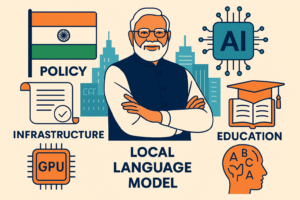How AI is Changing the Education System in India
If you’re a student or a parent in India, chances are you’ve already felt it: education doesn’t look or feel the same as it did five years ago. Blackboards are being replaced with smart screens. Homework isn’t just done on paper—some kids are chatting with AI tutors who help with their doubts 24/7. Even how we prepare for exams, pick career paths, or learn languages is changing. What’s driving all this? One big reason is Artificial Intelligence—or AI, as everyone calls it.
In this article, we’ll walk you through exactly how AI is shaking up the Indian education system in 2025. Whether you’re a 12-year-old figuring out how to deal with your math homework or a parent wondering if the new tech is really helping your child learn, this guide will help you understand what’s happening and why it matters.
The Education Scene in India Before AI Took Over
Just a few years ago, most classrooms in India looked pretty similar. Students sat in rows, teachers stood in front, and lessons were taught from textbooks. There was a lot of “one-size-fits-all” teaching. If you got the concept, great. If not, tough luck—you had to keep up.
But India’s classrooms weren’t failing because of bad teachers or lazy students. The real problem? Too many students, too few teachers, and not enough personalized attention. Add to that the struggle of learning during the COVID-19 pandemic, and it became super clear: something had to change.
Enter AI: The New “Chalk and Duster”
AI stepped in like a supercharged helper—kind of like Iron Man’s Jarvis but for schools. Here’s how it’s slowly becoming a regular part of classrooms across India.
1. Personalized Learning for Every Student
Let’s start with something simple: not all kids learn the same way. Some pick things up by reading, others need videos, and some just want to ask questions until it clicks. AI can actually learn how a student learns best—and then adjust.
📘 Example:
Imagine a 7th-standard student in Pune named Rhea. She’s struggling with fractions in math. Her school uses an AI app that notices she’s getting stuck on word problems. It automatically gives her easier questions first, then slowly makes them harder as she improves. Within a week, she’s solving problems she couldn’t even look at before.
This isn’t science fiction. Apps like BYJU’S, Toppr, and Khan Academy India are already using AI to do this kind of thing.
2. 24/7 AI Tutors – No More Waiting for the Next Class
Remember that feeling when you had a doubt at 9 PM the night before an exam and couldn’t reach your teacher? That’s not a problem anymore.
AI-powered bots like Wolfram Alpha, Doubtnut, and ChatGPT (hi, that’s me!) can explain concepts, solve problems, and answer questions—any time, any day.
🧠 Fictional Scenario:
A boy named Arjun in Indore uses an AI study assistant called “SmartPal.” One night, he’s stuck on a tough science question. Instead of waiting for his tuition class, he types it in, and SmartPal gives him an easy, step-by-step explanation in Hindi.
For kids in small towns or villages where coaching classes are hard to find, these tools are like having a genius cousin who’s always free to help.
3. Teachers Are Becoming Super Teachers
AI doesn’t replace teachers—it helps them teach better.
🧑🏫 Teachers can now:
- Instantly see which students are falling behind
- Get automatic suggestions for assignments
- Use tools that translate lessons into regional languages like Tamil, Marathi, or Bengali
- Even generate question papers based on what the class needs more practice in
📍Local Note: In places like Chennai and Jaipur, some government schools are using AI dashboards to track student progress. Teachers can see at a glance who needs more help with English grammar or geometry.
4. No More Cheating in Exams (Well, Almost)
Exams are a big deal in India. Whether it’s board exams, JEE, NEET, or even class tests, there’s always pressure—and sometimes, cheating.
AI is being used to catch unfair practices. Online proctoring tools (fancy word for online exam monitors) use webcams, face recognition, and behavior tracking to flag suspicious activity.
📝 Example:
During a mock NEET exam on a learning platform, the AI notices that one student is looking away from the screen too often. It alerts the teacher, who later reviews the footage. No more copying from chits hidden under the table!
5. Learning Is No Longer Just in English
India is a country of many languages. For years, a student who didn’t understand English well often fell behind—even if they were smart. AI is helping fix that.
✨ Tools like Google Translate or AI voice assistants now help translate textbooks, instructions, and questions into regional languages—often instantly.
🌍 Real-Life Parallel:
A 6th grader in Assam now watches science videos in Assamese. Her AI tutor translates tough English words into simple local phrases. She’s finally enjoying science, not just memorizing it.
6. AI Is Helping Students with Disabilities
Kids who are visually impaired, have hearing difficulties, or face learning challenges like dyslexia now have more support than ever.
📱 AI-based apps can:
- Read text out loud (Text-to-Speech)
- Convert speech into text (Speech-to-Text)
- Give personalized exercises based on each student’s needs
💡 Fictional Note:
Ravi, a student in Hyderabad who has trouble with reading, uses an AI reading assistant. It helps him understand class stories and even reads his homework questions aloud during online classes.
7. Career Counseling Is Smarter Now
“What do you want to be when you grow up?”—this question now has help from AI too.
Career guidance platforms in India are using AI to:
- Suggest careers based on interests and strengths
- Match students with mentors
- Show paths to non-traditional jobs like digital artist, AI engineer, or YouTuber
📊 Cool Fact: Tools like Mindler and Univariety are already used in many private schools in Delhi and Mumbai. They give students quizzes and suggest career paths—from IAS officer to ethical hacker.
8. Rural Areas Are Catching Up
For years, there was a huge education gap between cities and villages. AI might be the game-changer here.
With cheap smartphones, 4G (and now 5G) networks, and AI-powered educational apps that work even offline, students in remote places are getting more learning resources.
🚜 Imagine This:
A boy in rural Odisha doesn’t have a coaching class in his village. But he uses an app that works offline and teaches him in Odia. He’s preparing for the Class 10 board exams—on his own—and he’s not falling behind city kids.
So, What’s the Catch?
Okay, AI sounds amazing. But there are some challenges too:
- Not every school has internet or digital infrastructure
- Some students can’t afford devices like smartphones or laptops
- AI can sometimes give wrong answers if not used carefully
- Teachers and parents still need training to use these tools properly
But even with these issues, the direction is clear: AI is here to stay in Indian education.
FAQs About AI in Indian Education
1. Is AI replacing teachers?
Nope. AI is more like a helper or assistant. Teachers are still in charge.
2. Are AI tools free?
Some are, like Khan Academy or ChatGPT’s free version. Others cost money, but there are often scholarships or government programs.
3. Can AI help with regional board exams?
Yes. Many apps now support state boards and offer lessons in local languages.
4. Is AI safe for kids to use?
Mostly yes, but parents should monitor usage and check what apps kids are using.
Final Thoughts
In 2025, AI isn’t just some fancy buzzword—it’s the invisible hand guiding millions of Indian students every day. From personalized learning to smarter exams and better career guidance, it’s changing how we think about education.
And the best part? You don’t need to live in a big city or go to a posh school to benefit. With the right tools, the classroom is now in your pocket.
So whether you’re a student in a Mumbai school or a small village in Madhya Pradesh, AI is making it possible for you to learn smarter, faster, and in your own way.
And honestly, that’s pretty cool.














Post Comment